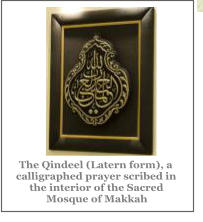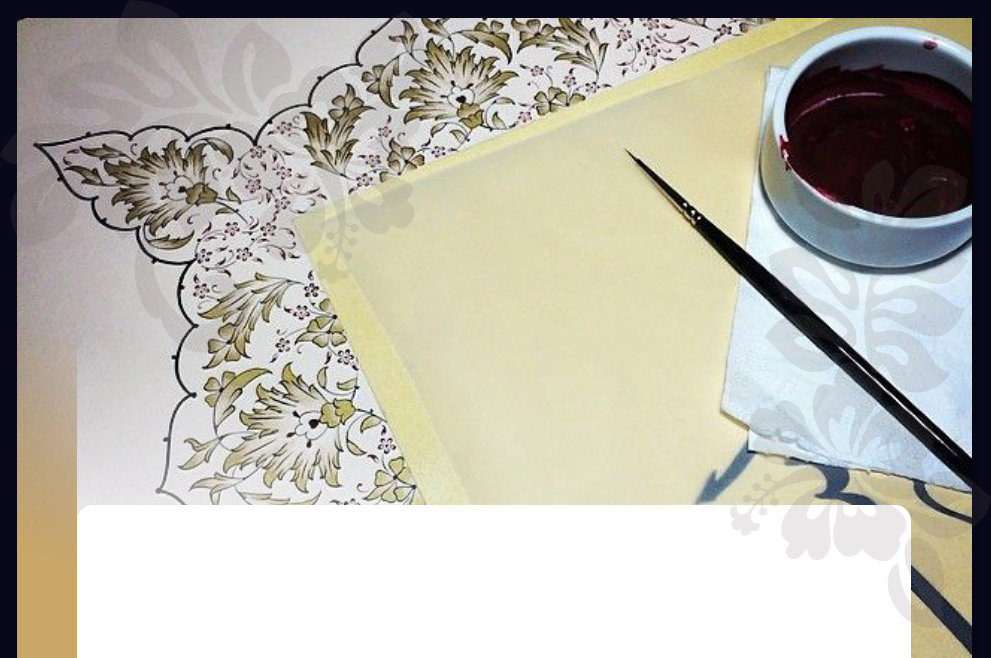

Al-Faraheedi

Copyright © 2011-2018 Academia-srt Network, All Rights Reserved
Evolution of the Quranic Script
Arabic Calligraphy, A Unique Islamic Art
When we ponder over the manifestations of different artistic creative phenomena in the Islamic Arabic civilization across history, we find that Arabic calligraphy is an outstanding manifestation of creativity among the Muslims. In the course of history, a great number of calligraphers have distinguished themselves as great exponents of beauty in the Arabic calligraphy and wrote Mus- hafs in private and public domains. The leading styles for writing the Mus-haf was the Kufi style which continued till the fifth century after Hijra. Then the Mus-haf was written in the Thuluth style up to the ninth century after Hijra. Finally the Naskh style has come to stay and continues to be so till our time. The earliest calligrapher in the field of writing Mus-hafs was Khalid bin Abi-l- Hayyaj who was a secretary to Al-Walid ibn Abdul-Malik. Towards the end of the Umayyad caliphate, the change of the calligraphic style from al-Kufi to something close to what we have today started at the hand of Qutbah Al-Muharir in the year 154 after Hijra. With the dawn of the 3rd century, the leadership of calligraphy passed on to Abu Ali Muhammad ibn Ali bin Muqlah, the minister who died in 328 after Hijra, and his brother Abu Abdillaah Al-Hasan ibn Ali who died in 338 after Hijra. Ibn Muqlah remained a leading figure in the development of Arabic calligraphy. After him the leadership of calligraphy passed on to Abu-l-Hasan Ali ibn Hilal Al- Baghdadi, known as Ibn Al-Bawwaab who died in 413 after Hijra and was given the title of the king of Calligraphy. He committed the Quran to memory and wrote 62 Mus-haf of which two are still of existence till this day. One in Chester Biti Library in Dublin, and the other in Lalilli Library in Istanbul. The original writings by Ibn Al-Bawwaab remained great examples which were followed by calligraphers over a period of three centuries continuously. In the 7th century, Yaqut ibn Abdillaah Al-Mutasimi who died in 698 after Hijra, the best calligrapher of his time emerged. Most of his works that survived till date in his handwriting are the Mus-hafs and they are in Ar-Rayhani style of writing. Al-Maghribi style of writing spread in north, central and west Africa, and in Spain the style developed from Al-Kufi style which was widely used for writing the Mus- haf in that region. A number of the inhabitants of Spain were known for writing the Mus-haf and their proficiency in adding the two types of dots, dots of i'raab and dots of i'jaam. Amongst the most famous of them was Muhammad Ibn Abdillah Ibn Sahl Al-Ansaari known as Ibn Ghatous the calligrapher of Valencia who died in 610 after Hijra. The interest in calligraphy and writing of the Mus-haf reached Persia also were the people excelled in gilding. They developed writing styles peculiar to them like the naskh-taleeq style which is a combination of An-Naskh and At-Taleeq. It appeared in the 9th century and several Mus-hafs were written using this style. The Ottoman empire showed keen interest in calligraphy and writing of the Mus-haf. Calligraphy in Turkey received the patronage of the Sultans. As a result, a number of Turks appeared as outstanding calligraphers of the Mus-haf such as Al-Hafiz Othman who died in 1110 after Hijra. The Othman Turks excelled in gilding and decorating the Mus-hafs.Printing of the Quran
In the year 840 after Hijra 1446CE, printing was invented and used in the German town of Mains, and Turkey was the first country in the east to know the use of modern printers. Later on, other countries in the Arab and Islamic world started using the printers. However, printed Mus-hafs emerged in Europe before any other place for 3 editions were printed in the 16th and 17th century CE namely the Venetian edition in Italy, the Hamburg edition in Germany, and the Batavian edition from Patavianon in Italy now known as Padua. After these three editions, efforts were made to print the noble Mus-haf but these were full of mistakes, and the motive made for such efforts were surrounded by suspicion. After that, the Noble Mus-haf was printed in Iran, India, and Turkey. The first Mus-haf printed in the Arabian Maghreb (furthest to the west) was in the year 1296 after Hijra 1879CE. In Egypt, the Mus-haf was printed in the year 1308 after Hijra 1890CE from the copy written by sheikh Al-Muqri Abu Eid Ridwan ibn Muhammad Al-Mukhallalaati who died in 1311 after Hijra in which he followed the Othman orthography. The mus-haf remained popular in Egypt until Sheikh Muhammad Ali Khalaf Al-Hussein popularly known as Al-Haddad who died in 1357 after Hijra wrote a mus-haf. It was called Al-ameen Mus-haf. Its first edition was published in the year 1342 after Hijra 1923CE and gained widespread acceptance. Afterwards, the printing of mus-hafs continued uninterrupted in Egypt, Iraq, Sham, Hejaz, India, Pakistan, and other parts of the Arab and Muslim Worlds. The beginning of mus-haf printing in the kingdom of Saudi Arabia can be traced to the year 1369 after Hijra when the Mecca Mus-haf appeared during the Second World War It was written by the Calligrapher Muhammad Tahir Al-Kurdi who died in 1400 after Hijra in accordance with the Othmanic orthography. Thirty years after the publication of the Mecca Mus-haf, another mus-haf was printed in Jeddah by Ar-Rawdah printers after it was revised and approved by the concerned authorities. In the month of Safar of the year 1405 after Hijra 1984CE, the inauguration of the greatest center for the printing of the glorious Quran in Al-Medina Al-Munawwarah, the cradle of Islam, was announced. It was named King Fahd Glorious Quran Printing Complex and the mus-haf printed therein according to the various accepted readings has been named the mus-haf of the Prophet's City. It is the gift of the custodian of the two Holy Mosques to the Muslims all over the world. This mus-haf has gained widespread acceptance in all parts of the Muslim world on account of its great excellence in both the scholarly and technical aspects. The first mus-haf published by the complex and its printers was in the year 1405 after Hijra, it was according to the readings of Hafs and Asim. It was written by the Calligrapher Othman Taha in the Naskh style and was revised by a scholarly committee of a very high standard. Later the complex wrote a new mus-haf which was also according to the reading of Hafs and Asim. It was published in the year 1422 after Hijra. It was also written in the Naskh style which is the most amiable style of writing and therefore the most suitable one for writing the Quranic text and this mus-haf is exceptional because of its marvelous calligraphy that is very comfortable for the eyes. The Quranic letters therein have a great degree of clarity. Its revision and careful examination was carried out by the scholarly committee for revising Mus-haf al-Medina An-Nabawiyyah (the Enlightened City) according to the accepted readings. The revision was carried out in five stages. The first stage is revising what the calligrapher has written before adding the dhabt (diacritics). This is done by members of the scholarly committee who verified that the Quranic text is free from mistakes and that it conforms to the Quranic orthography in all its aspects. The second stage is the revision of the Quranic text after adding the dhabt (diacritics). The scholarly committee now examines the Quranic text word by word with respect to the vowel signs and other signs of dhabt according to the reading in which the mus-haf is written. The committee also checks the numbering of the ayat (verses) and their sequence, page numbers, signs indicating the divisions of mus-haf into ajzaa (parts) etc, the signs indicating the ayat (verses) requiring prostration and so on. The third stage is the stage which spelling check is carried out. It is of immense importance because it covers all that is connected with the mus-haf. The committee in this stage is divided in two groups, one reading the text and the other listening to it. Each word is spelled and each letter of the word is read along with its vowel sign. This is done from the beginning of the Quran to its end. The fourth stage is to review the copy made by the montage department in the original after the spelling check stage. Specific pages of the copy are shared among the members of the committee so that the entire mus-haf is read from the beginning to the end. If after all these stages no mistakes are discovered, the committee decides that the mus-haf under scrutiny is perfectly suitable for printing. The fifth stage, the committee once again revises the printed copy before it is allowed for distribution. It should be noted that revision for some of the advance stages is repeated and thus sometimes making a total revision of more than 100 times of the complete mus-haf. There is a department in the complex known as product control department. It embraces a number of units namely text control unit, unit of quality control on production lines, and final control unit. The work of these units is considered complimentary to that of the scholarly committee. With the help of Allah, the King Fahd Printing Complex has been able to print the mus-haf in five different readings up to the year 1431 after Hijra 2010. These are mus-hafs according to the reading of Hafs and Asim, mus-hafs according to the reading of Warsh and Nafi, mus-hafs according to the reading of Qalon and Nafi, mus-hafs according to the reading of Ad-Duri and Abi Amr Al-Basri, mus- hafs according to the reading of Shuba and Asim. Work is currently in progress for printing mus-hafs according to all the ten accepted readings. We ask Allah the most high to recompense the government of the Kingdom of Saudi Arabia headed by the custodian of the two Holy Mosques King Abdullah bin Abdul-Aziz Al-Saud, his royal highness Crown Prince Sultan ibn Abdul-Aziz, and his royal highness the second deputy premier Prince Naif ibn Abdul-Aziz with the best reward for disseminating the book of Allah. "Had we sent this Quran on a mountain you would surely have seen it humbling itself and went descended by the fear of Allah. Such are the parables which we put forward to mankind that they may reflect" [Quran: Chapter 59-Verse 21].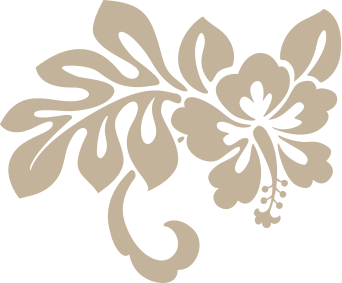
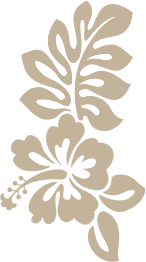


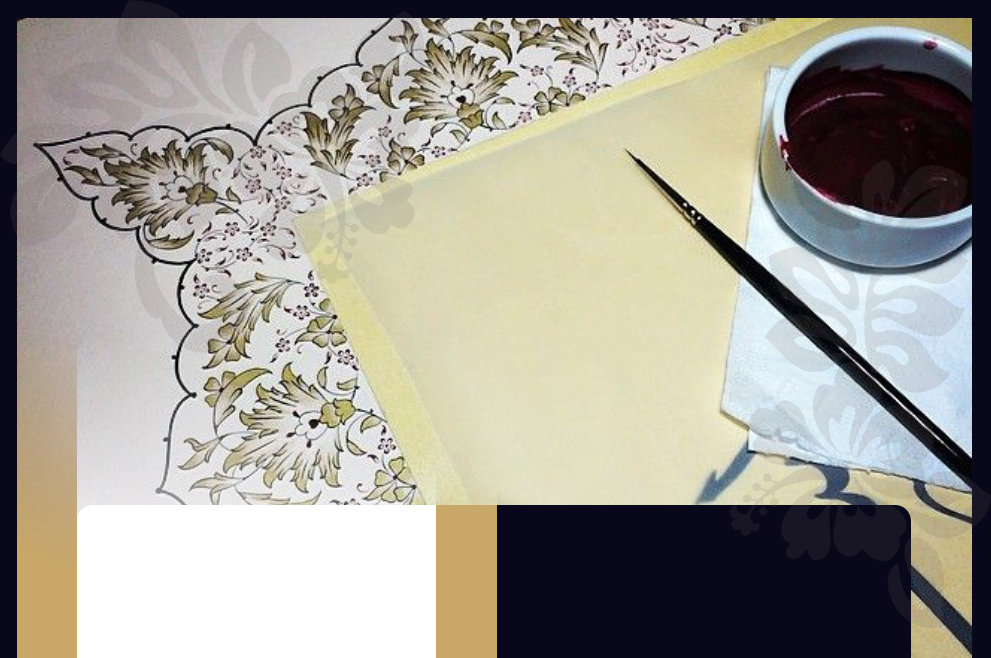

Al-Faraheedi

Copyright © 2011-2018 Academia-srt Network, All Rights Reserved
Evolution of the
Quranic Script
Arabic Calligraphy, A Unique
Islamic Art
When we ponder over the manifestations of different artistic creative phenomena in the Islamic Arabic civilization across history, we find that Arabic calligraphy is an outstanding manifestation of creativity among the Muslims. In the course of history, a great number of calligraphers have distinguished themselves as great exponents of beauty in the Arabic calligraphy and wrote Mus-hafs in private and public domains. The leading styles for writing the Mus-haf was the Kufi style which continued till the fifth century after Hijra. Then the Mus-haf was written in the Thuluth style up to the ninth century after Hijra. Finally the Naskh style has come to stay and continues to be so till our time. The earliest calligrapher in the field of writing Mus-hafs was Khalid bin Abi-l-Hayyaj who was a secretary to Al-Walid ibn Abdul-Malik. Towards the end of the Umayyad caliphate, the change of the calligraphic style from al-Kufi to something close to what we have today started at the hand of Qutbah Al-Muharir in the year 154 after Hijra. With the dawn of the 3rd century, the leadership of calligraphy passed on to Abu Ali Muhammad ibn Ali bin Muqlah, the minister who died in 328 after Hijra, and his brother Abu Abdillaah Al-Hasan ibn Ali who died in 338 after Hijra. Ibn Muqlah remained a leading figure in the development of Arabic calligraphy. After him the leadership of calligraphy passed on to Abu-l-Hasan Ali ibn Hilal Al-Baghdadi, known as Ibn Al-Bawwaab who died in 413 after Hijra and was given the title of the king of Calligraphy. He committed the Quran to memory and wrote 62 Mus-haf of which two are still of existence till this day. One in Chester Biti Library in Dublin, and the other in Lalilli Library in Istanbul. The original writings by Ibn Al- Bawwaab remained great examples which were followed by calligraphers over a period of three centuries continuously. In the 7th century, Yaqut ibn Abdillaah Al-Mutasimi who died in 698 after Hijra, the best calligrapher of his time emerged. Most of his works that survived till date in his handwriting are the Mus-hafs and they are in Ar- Rayhani style of writing. Al-Maghribi style of writing spread in north, central and west Africa, and in Spain the style developed from Al-Kufi style which was widely used for writing the Mus-haf in that region. A number of the inhabitants of Spain were known for writing the Mus- haf and their proficiency in adding the two types of dots, dots of i'raab and dots of i'jaam. Amongst the most famous of them was Muhammad Ibn Abdillah Ibn Sahl Al-Ansaari known as Ibn Ghatous the calligrapher of Valencia who died in 610 after Hijra. The interest in calligraphy and writing of the Mus-haf reached Persia also were the people excelled in gilding. They developed writing styles peculiar to them like the naskh- taleeq style which is a combination of An-Naskh and At- Taleeq. It appeared in the 9th century and several Mus- hafs were written using this style. The Ottoman empire showed keen interest in calligraphy and writing of the Mus-haf. Calligraphy in Turkey received the patronage of the Sultans. As a result, a number of Turks appeared as outstanding calligraphers of the Mus-haf such as Al- Hafiz Othman who died in 1110 after Hijra. The Othman Turks excelled in gilding and decorating the Mus-hafs.Printing of the Quran
In the year 840 after Hijra 1446CE, printing was invented and used in the German town of Mains, and Turkey was the first country in the east to know the use of modern printers. Later on, other countries in the Arab and Islamic world started using the printers. However, printed Mus-hafs emerged in Europe before any other place for 3 editions were printed in the 16th and 17th century CE namely the Venetian edition in Italy, the Hamburg edition in Germany, and the Batavian edition from Patavianon in Italy now known as Padua. After these three editions, efforts were made to print the noble Mus-haf but these were full of mistakes, and the motive made for such efforts were surrounded by suspicion. After that, the Noble Mus-haf was printed in Iran, India, and Turkey. The first Mus-haf printed in the Arabian Maghreb (furthest to the west) was in the year 1296 after Hijra 1879CE. In Egypt, the Mus-haf was printed in the year 1308 after Hijra 1890CE from the copy written by sheikh Al-Muqri Abu Eid Ridwan ibn Muhammad Al-Mukhallalaati who died in 1311 after Hijra in which he followed the Othman orthography. The mus-haf remained popular in Egypt until Sheikh Muhammad Ali Khalaf Al-Hussein popularly known as Al-Haddad who died in 1357 after Hijra wrote a mus-haf. It was called Al-ameen Mus-haf. Its first edition was published in the year 1342 after Hijra 1923CE and gained widespread acceptance. Afterwards, the printing of mus-hafs continued uninterrupted in Egypt, Iraq, Sham, Hejaz, India, Pakistan, and other parts of the Arab and Muslim Worlds. The beginning of mus-haf printing in the kingdom of Saudi Arabia can be traced to the year 1369 after Hijra when the Mecca Mus-haf appeared during the Second World War It was written by the Calligrapher Muhammad Tahir Al-Kurdi who died in 1400 after Hijra in accordance with the Othmanic orthography. Thirty years after the publication of the Mecca Mus-haf, another mus-haf was printed in Jeddah by Ar-Rawdah printers after it was revised and approved by the concerned authorities. In the month of Safar of the year 1405 after Hijra 1984CE, the inauguration of the greatest center for the printing of the glorious Quran in Al-Medina Al-Munawwarah, the cradle of Islam, was announced. It was named King Fahd Glorious Quran Printing Complex and the mus-haf printed therein according to the various accepted readings has been named the mus-haf of the Prophet's City. It is the gift of the custodian of the two Holy Mosques to the Muslims all over the world. This mus-haf has gained widespread acceptance in all parts of the Muslim world on account of its great excellence in both the scholarly and technical aspects. The first mus-haf published by the complex and its printers was in the year 1405 after Hijra, it was according to the readings of Hafs and Asim. It was written by the Calligrapher Othman Taha in the Naskh style and was revised by a scholarly committee of a very high standard. Later the complex wrote a new mus- haf which was also according to the reading of Hafs and Asim. It was published in the year 1422 after Hijra. It was also written in the Naskh style which is the most amiable style of writing and therefore the most suitable one for writing the Quranic text and this mus-haf is exceptional because of its marvelous calligraphy that is very comfortable for the eyes. The Quranic letters therein have a great degree of clarity. Its revision and careful examination was carried out by the scholarly committee for revising Mus-haf al- Medina An-Nabawiyyah (the Enlightened City) according to the accepted readings. The revision was carried out in five stages. The first stage is revising what the calligrapher has written before adding the dhabt (diacritics). This is done by members of the scholarly committee who verified that the Quranic text is free from mistakes and that it conforms to the Quranic orthography in all its aspects. The second stage is the revision of the Quranic text after adding the dhabt (diacritics). The scholarly committee now examines the Quranic text word by word with respect to the vowel signs and other signs of dhabt according to the reading in which the mus-haf is written. The committee also checks the numbering of the ayat (verses) and their sequence, page numbers, signs indicating the divisions of mus-haf into ajzaa (parts) etc, the signs indicating the ayat (verses) requiring prostration and so on. The third stage is the stage which spelling check is carried out. It is of immense importance because it covers all that is connected with the mus-haf. The committee in this stage is divided in two groups, one reading the text and the other listening to it. Each word is spelled and each letter of the word is read along with its vowel sign. This is done from the beginning of the Quran to its end. The fourth stage is to review the copy made by the montage department in the original after the spelling check stage. Specific pages of the copy are shared among the members of the committee so that the entire mus-haf is read from the beginning to the end. If after all these stages no mistakes are discovered, the committee decides that the mus-haf under scrutiny is perfectly suitable for printing. The fifth stage, the committee once again revises the printed copy before it is allowed for distribution. It should be noted that revision for some of the advance stages is repeated and thus sometimes making a total revision of more than 100 times of the complete mus-haf. There is a department in the complex known as product control department. It embraces a number of units namely text control unit, unit of quality control on production lines, and final control unit. The work of these units is considered complimentary to that of the scholarly committee. With the help of Allah, the King Fahd Printing Complex has been able to print the mus- haf in five different readings up to the year 1431 after Hijra 2010. These are mus-hafs according to the reading of Hafs and Asim, mus-hafs according to the reading of Warsh and Nafi, mus-hafs according to the reading of Qalon and Nafi, mus-hafs according to the reading of Ad-Duri and Abi Amr Al-Basri, mus-hafs according to the reading of Shuba and Asim. Work is currently in progress for printing mus-hafs according to all the ten accepted readings. We ask Allah the most high to recompense the government of the Kingdom of Saudi Arabia headed by the custodian of the two Holy Mosques King Abdullah bin Abdul-Aziz Al-Saud, his royal highness Crown Prince Sultan ibn Abdul-Aziz, and his royal highness the second deputy premier Prince Naif ibn Abdul-Aziz with the best reward for disseminating the book of Allah. "Had we sent this Quran on a mountain you would surely have seen it humbling itself and went descended by the fear of Allah. Such are the parables which we put forward to mankind that they may reflect" [Quran: Chapter 59-Verse 21].


